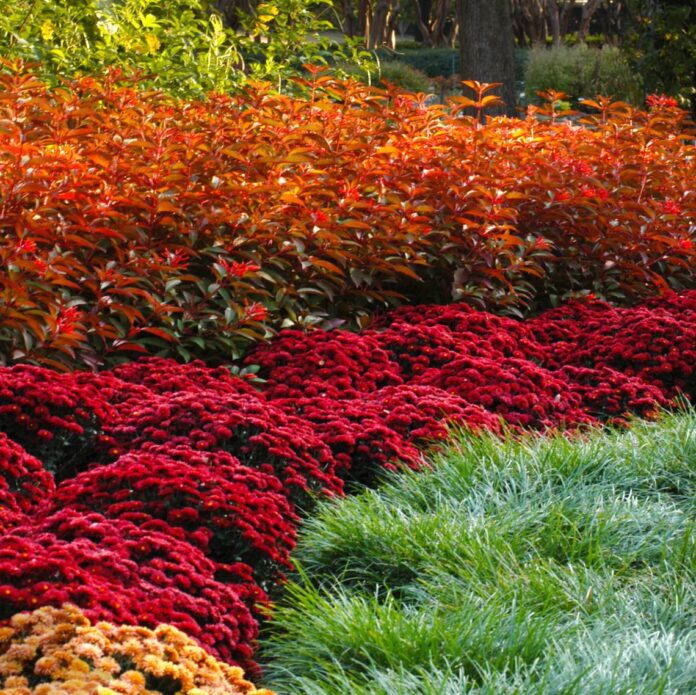It’s been fun shopping Texas nurseries these past couple of weeks because you can see the first signs of autumn. Of course, Halloween décor is hitting their gift shops, but I’m talking about plants — the plants that will look good with the pumpkins that should start rolling in sometime in September.
Begging forgiveness of the legions of Aggies, we’re going to talk about plants that bring “orange” to their surroundings — the plants that either have orange leaves or orange flowers (or both) as fall’s cooler weather arrives. These are my favorites.
Marigolds. We might as well start out with the easiest. These are one of the most popular annuals of all time, and when you grow them in the fall you bypass spider mites that ruin them in many spring gardens. You also get more intense colors. Set out transplants now, preferably in bud and just coming into bloom. There are many lovely orange (and yellow) types in all mature sizes.
Zinnias. What I just wrote about marigolds goes for zinnias as well. Their colors are two shades more intense with cooler temperatures than they are in hot weather of summer. You’ll seldom see them in individual colors like orange when you buy transplants in nurseries, but you could grow your own another year. There are many fine types ranging in mature height from 8 to 36 inches.
Celosias. Most of us think first of deep screaming reds when it comes to the plants, also called “cockscombs,” but some rich oranges are also sold. They love the autumn, and it’s a rare day when insects or diseases find them.
Lantanas. No plant that we grow handles the heat of a Texas mid-summer any better, and yet lantanas coast into fall in fine flowering fashion as well. Butterflies, hummingbirds, bees of all kinds, and other pollinators are in love with this plant, and so are almost all Texas gardeners. The native type from the Hill Country fits our requirement for orange perfectly, and it comes back after most Texas winters.
Crossandras. Although it’s not really a bedding plant, this glorious baby is commonly used to decorate patios and entries. Its flowers are as refreshing as orange sherbet, and they keep coming for weeks. No plant will bring a more beautiful shade of orange to your life.
Bougainvilleas. Once again, our minds wander off to other shades when this name comes up, but there are some lovely orange types in the market. These are tropical vines that will require a bright, warm place to spend their winters if you expect them to survive from one year to the next. Otherwise, just treat them as special annuals and enjoy those colorful bracts.
Firebush. Now we’re splitting the difference. This lovely plant, brought into the market by the nurturing hands of famed Texas plant man Greg Grant, has coppery-orange leaves once it turns cool. That’s the perfect backdrop to its scores of handsome orange tubular flowers that drive hummingbirds wild. We use it as an annual in North Texas, although it’s a tender perennial farther south.


Copper plants. These came into the Texas landscaping trade around 1960. They were stars for about 30 years, but interest has waned in the past 25 years. That’s too bad, because there are some really nice selections available in the nursery industry. Keep your eyes open. You might find just the right one to complement your color scheme this fall.
Crotons. No plant has so caught the eye of Texas gardeners and commercial landscapers as crotons, even to the point of their being used in massed plantings in beds all season long. Even if you just use them to highlight your Halloween decorations, crotons will win your heart. There are so many types with so many leaf colors and patterns. Keep them indoors in the brightest window in your house over the winter.
Joseph’s coat. Our grandmothers’ mothers grew these. Little green sprawling plants that suddenly changed into all shades of yellow, rust, and our obligatory orange as soon as days grew shorter and cooler. These plants are stunning, although we don’t see them nearly often enough.


Ornamental peppers. Use these in a large, decorative pot or planter, or mass them in the front of a garden bed. However you use them, they are absolutely gorgeous. As they ripen, their small peppers will go through a rainbow of colors, often including green to yellow and on to orange and perhaps red or purple. The only thing that is certain is that almost all of them are very hot. Very, very hot. Not great for fresh eating by the handful.
So, that’s your list of plants that will provide orange to your surroundings. Get them set out and growing now and you’ll be ready by the time the Floydada pumpkins arrive. You’ll be able to pick out your pumpkin, bring it home, and plunk it in place.

